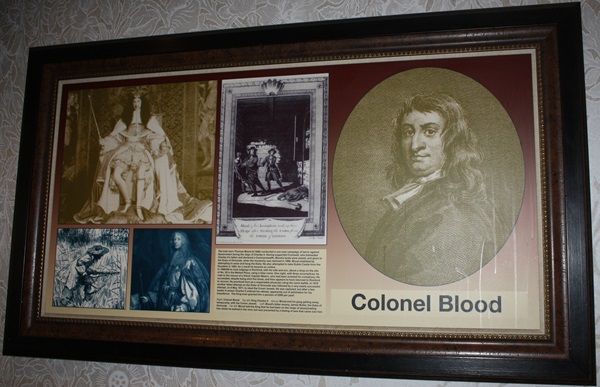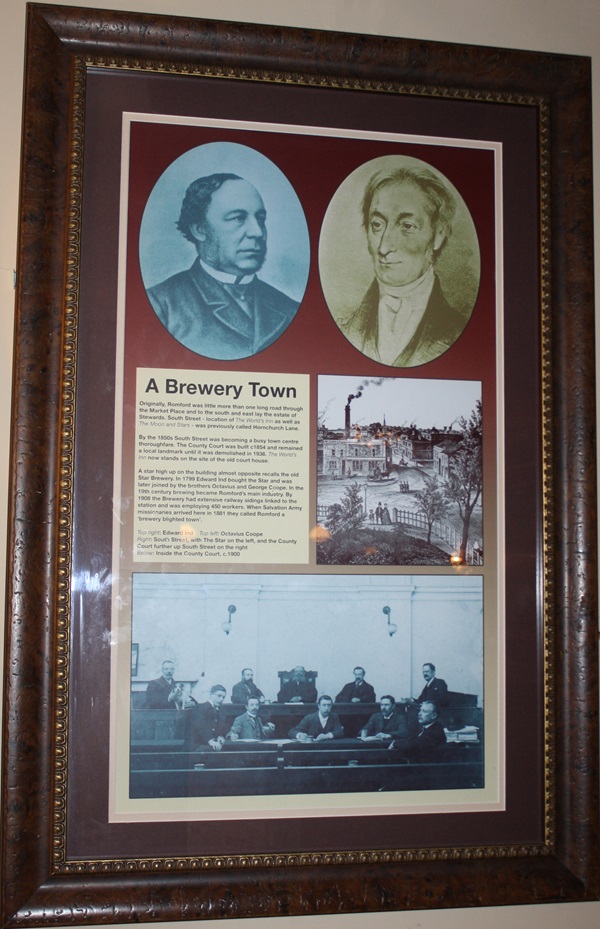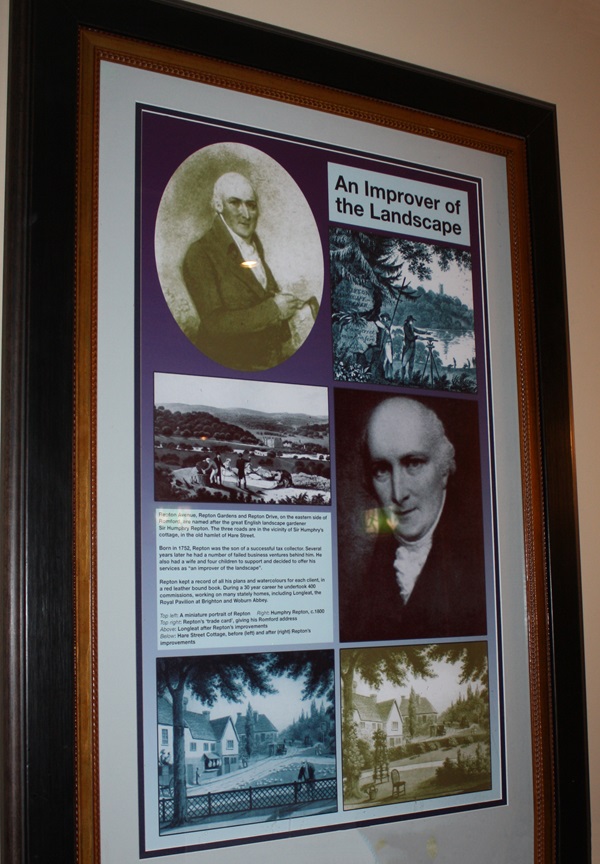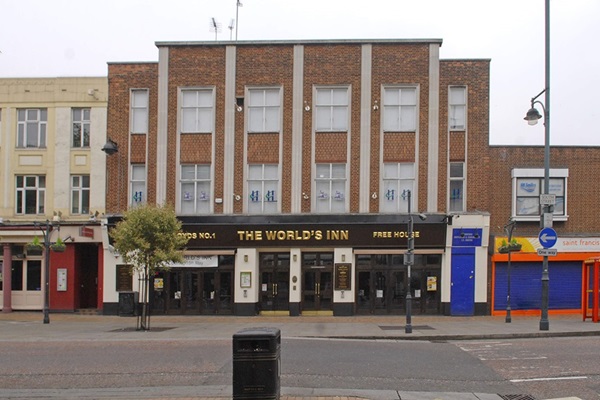South Street was originally a trackway by the River Rom. By the 1850s, it was a busy town-centre street. The county court was a feature of the street, until its demolition in 1936. This pub stands on the site of the court house and takes its name from a poem by Francis Quarles, Romford’s very own poet. In his poem On the World, published in 1635, he wrote that ‘The World’s an Inn: and I her guest’.
Framed illustrations and text about The World’s Inn.

The text reads: Francis Quarles is Romford’s very own poet, who most popular work, Emblems, was published in 1635. In his poem, On the World, Quarles wrote that, “The world’s an Inn: and I her guest”.
He was born at the fine old manor house on the Stewards estate, at the Market Place end of South Street. The estate stretched all the way down the east side of South Street, covering the site of the building that you are now in.
Quarles was orphaned at an early age. He later studied law and married in 1618. He and his wife had 18 children, and, at times, were very poor. Francis turned his energies to writing, and established a lasting reputation as a poet. He is remembered locally by Havering College’s Quarles Campus.
Top: Portrait of Francis Quarles engraved in 1645
Above: The frontispiece of Quarles’ ‘Emblems’, 1635.
Framed illustrations, print and text about Francis Quarles.

The text reads: The Quarles family owned the Stewards estate, which covered an area from South Street right up to Balgores Lane and the Drill Corner in Gidea Park.
When it was built, their manor house stood in a large park, which was later divided into farmland. Francis Quarles (born 1592 died 1644), the brother of Sir Robert and a famous poet, lived there as a child.
Francis was a Royalist, a supporter of the traditional monarchic system, but by temperament he was something of a puritan, as were the anti-Royalist faction. His poems clearly show this. They are highly religious and concentrate on the road to hell rather than the highway to heaven. He published several books, including, Emblems and A Feast of Worms. As the younger son, he inherited little as was always in financial difficulty. He fathered at least 18 children of his own, of whom 13 survived, which kept him always needy. Persecution by the Parliamentarian opponents of the King, who took exception to his Royalist sympathies, helped bring about his premature death.
Left: Portrait of Francis Quarles
Top left: Frontispiece to Quarles’ The Shepherd’s Oracles, showing the ‘Root and ranch’ party attacking the ‘Tree of Religion
Top centre: ‘Divine Love’ raises the ‘Lost Soul’
Top right: The captive soul, from Quarles’ Emblems Divine and Moral
Above: William Blake’s sketch of the same idea, A Boy inside a Birdcage.
Framed illustrations and text about Colonel Blood.

The text reads: The Irish-born Thomas Blood (d.1680) conducted a one-man campaign of terror against Government during the reign of Charles II. Having supported Cromwell, who beheaded Charles’s II father and declared a Commonwealth, Blood’s lands were seized, and given to the Duke of Ormonde, when the monarchy was restored in 1660. Blood retaliated by attempting to seize and hang the Duke. He also attempted to take Dublin Castle from the Royalists in 1663. As a result he became an outlaw.
In 1666/68 he took lodgings in Romford, with his wife and son, above a shop on the site of No. 33 in the Market Place, using a false name. One night, with three accomplices, he rode to the rescue of a friend, captain Mason, who had been arrested for conspiracy. He succeeded, despite being shot 5 times, and then appears to have returned to Romford to recover. He practiced here as a respectable physician using the name Ayliffe. In 1670 another failed attempt on the Duke of Ormode was followed by a very nearly successful attempt, on 9th May 1671, to steal the Crown Jewels. He was captured, but after a few weeks in prison Charles II ordered his released, apparently out of admiration for his impudence. The King even granted him a pension of £500 per year!
Right: Colonel Blood
Top left: King Charles II
Above: Blood and his gang getting away, temporarily, with the Crown jewels
Left: Blood’s bitter enemy, James Butler, the Duke of Ormonde
Far left: Blood told the King that he had been on the verge of assassinating him whilst he bathed in the river, but was prevented by a feeling of awe that came over him.
Framed illustrations, photograph and text about Star Brewery.

The text reads: Originally, Romford was little more than one long road through the Market Place and to the south and east lay the estate of Stewards. South Street – location of The World’s Inn as well as The Moon and Stars – was previously called Hornchurch Lane.
By the 1850s South Street was becoming a busy town centre thoroughfare. The County Court was built c1854 and remained a local landmark until it was demolished in 1936. The World’s Inn now stands on the site of the old court house.
A star high up on the building almost opposite recalls the old Star Brewery. In 1799 Edward Ind bought the Star and was later joined by the brothers Octavius and George Coope. In the 19th century brewing became Romford’s main industry. By 1908 the Brewery had extensive railway sidings linked to the station and was employing 450 workers. When Salvation Army missionaries arrived here in 1881 they called Romford a ‘brewery blighted town’.
Top right: Edward Ind
Top left: Octavius Coope
Right: South Street, with The Star on the left, and the County Court further up South Street on the right
Below: Inside the County Court, c.1900.
Framed illustrations, prints and text about Sir Humphry Repton.

The text reads: Repton Avenue, Repton Gardens and Repton Drive, on the eastern side of Romford, are named after the great English landscape gardener Sir Humphry Repton. The three roads are in the vicinity of Sir Humphry’s cottage, in the old hamlet of Hare Street.
Born in 1752, Repton was the son of a successful tax collector. Several years later he had a number of failed business ventures behind him. He also had a wife and four children to support and decide to offer his services as “an improver of the landscape”.
Repton kept a record of all his plans and watercolours for each client, in a red leather bound book. During a 30 year career he undertook 400 commissions, working on many stately homes, including Longleat, the Royal Pavilion at Brighton and Woburn Abbey.
Top left: A miniature portrait of Repton
Right: Humphry Repton, c.1800
Top right: Repton’s ‘trade card’, giving his Romford address
Above: Longleat after Repton’s improvements
Below: Hare Street Cottage, before (left) and after (right) Repton’s improvements.
An external view of the pub – main entrance.

If you have information on the history of this pub, then we’d like you to share it with us. Please e-mail all information to: pubhistories@jdwetherspoon.co.uk